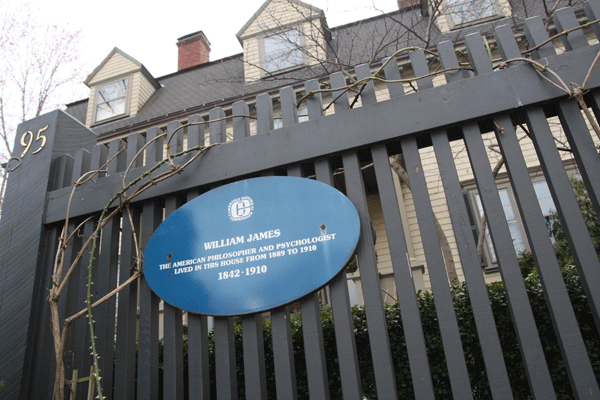1) William James House
95 Irving Street
The house at 95 Irving Street was built in 1889 for William James and designed by architect William Ralph Emerson in conjunction with James, who lived there with his family from 1889 to his death in 1910.
The William James House is architecturally significant as the work of William Ralph Emerson (1833-1918), a Boston architect who is best known for his Shingle Style designs, a number of which survive across New England. Emerson was a distant cousin of Ralph Waldo Emerson, who was close to Henry James Senior and blessed young William as a child.
William James lived in Cambridge for more than fifty years, but it is this home on Irving Street that was most special. James was so eager to occupy the home that he even moved the family in before construction was complete.
Letters to friends and family are full of praise for the house, especially its grand library-study--which is 22 feet wide and 27 feet long with floor-to-ceiling bookcases and has been preserved, along with the principle rooms of the first and second floor, through recent renovations.
One of James’s major works, The Principles of Psychology (1890), was written over a 12-year period preceding the construction of his house, but all of his later work was written while James resided on Irving Street, and it is this work that established his lasting influence in the fields of philosophy, psychology and educational theory. Among the works James published while resident on Irving Street are The Will to Believe and Other Essays in Popular Philosophy (1897), Talks to Teachers on Psychology; And to Students on Some of Life’s Ideals (1899), The Varieties of Religious Experience (1902), Pragmatism: A New Name for Old Ways of Thinking (1907), A Pluralistic Universe (1909), The Meaning of Truth (1909), and Some Problems in Philosophy (1911).
At the death of William James in 1910, the property passed first to William James’ widow, Alice Howe Gibbens James and, on her death in 1922, in four shares to their children, Henry, William, Alexander and Margaret. Members of the James family occupied the house until 1968, when James’s grandson sold the property to the President and Fellows of Harvard College. The President and Fellows of Harvard College retained ownership of the house until 1981 when it was purchased by Professor William Estes, who bought the house with the provision that Harvard had the right of first refusal to buy it when Estes wished to sell.
Estes proudly considered his home an extension of the Harvard psychology department, which is housed in Harvard's William James Hall. Estes hosted parties for the department to welcome incoming psychology students, talk about James and explain the house's rich history. Estes sold the house in 1999 to a private owner after the President and Fellows of Harvard College declined to exercise a right of first refusal to purchase the property, stating that the purchase of expensive real estate was not an appropriate way to meet academic space needs.
In his own time, though, William’s house was an academic space. James hosted students such as Gertude Stein and Marry Calkins, the first female president of the American Psychological Association, graduate student Edward Thorndike who used the basement here to raise the chickens he used to study animal intelligence, and scholars like neighbor and friend Josiah Royce.

